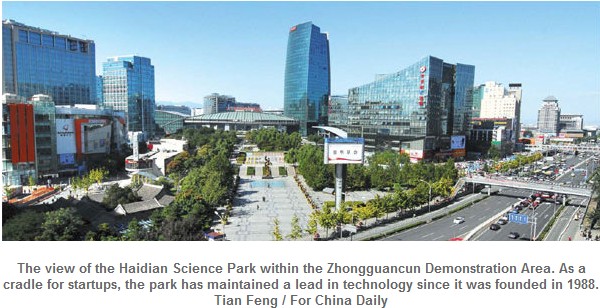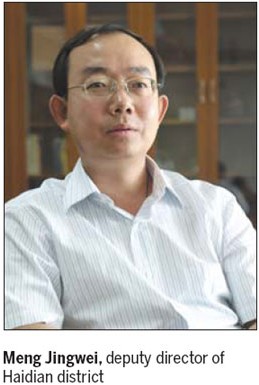Industrial alliances, new financing models help enterprises to thrive
A national innovation demonstration zone, Haidian Science Park in Beijing has been China's leading incubator of high-tech industries since it was founded in 1988.
Currently, the Haidian district hosts about 4,400 national-level high-tech enterprises, which account for one-tenth of the country's total.
And more than 70 percent of the leading enterprises of China's seven strategic emerging sectors base their operations here.

Last year, Haidian generated revenue totaling more than 1 trillion yuan ($163.9 billion), further consolidating its leading position in the country as the top district for technological innovation.
Meng Jingwei, deputy director of Haidian district, said that strong, innovative enterprises are one of the key factors that have driven the district's fast, sustained growth in the past 25 years.
Haidian is the birthplace of some famous domestic high-tech companies like Lenovo and Baidu.
It has nearly 10,000 technology-oriented startups, including more than 260 that are listed either on the Nasdaq or in China's growth enterprises market.
Among the global high-tech giants that have chosen Haidian as the location for their regional headquarters and R&D centers are big names like Microsoft, Oracle and IBM.
In 2012, about one-seventh of the nation's revenue from the software and information service industry was generated by companies in Haidian.
The support that organizations provide to businesses in Haidian is a crucial element of their success, Meng said.
The vibrant high-tech area now has 36 industry alliances and more than 40 associations and chambers of commence in different fields.

Together, they have nearly 60 key laboratories that are open to all the companies in the district. Such organizations have played an important role in integrating resources and advancing the commercialization of scientific research while improving the area's overall competitiveness and influence.
They have also made significant breakthroughs in the application of important scientific and technological achievements.
According to the local government, companies in Haidian have jointly established 66 international standards and 590 national standards in the application of new technology, such as the TD-SCDMA, intelligent grouping and resource sharing, and wireless personal area network.
The district's growing number of venture capital and private equity institutions is another major force that stimulates innovation in Haidian, Meng said.
It is also an exemplification of the growing influence of the market mechanism in the area, he said.
The latest statistics show that Haidian now has 594 equity investment organizations. The total capital managed by these groups exceeded 200 billion yuan by the end of 2012 and ranked third in the nation.
The district is home to more than 200 angel investors, about 70 percent of the national total.
Meng said that the local government plans to further enhance financing services to fund innovations and make Haidian a magnet for the capital that is needed to drive high-tech research.
"The two major obstacles on China's way to economic transformation now are capital and technology," Meng said.
"Haidian is trying to make breakthroughs in both aspects."
In addition to encourage financing, the local government of Haidian also plans to make the place a center for international technology transfer, he said.
Last year, technology transfers in the district had a total value of more than 100 billion yuan, which is one-fifth of the national total.
Meng said the district aims to attract more multinational providers of technology transfer services to the capital city and introduce advanced technologies to China.
It now has 45 domestic and overseas institutions engaged in technology transfer. The number is expected to increase to 100 by the end of this year.
"As the global industrial structure goes through an in-depth adjustment, developed countries are seeking to transfer their advanced technologies overseas, and emerging nations have become their first choice," Meng said.
"At the same time, China's industrial restructuring requires strong technological support."
Meng said the country must rely on the momentum of international technology transfer to drive China's economic growth.
Though the district has set the bar high with its past performance, Meng said the local government has high hopes and ambitious plans that the district can reach even greater heights in the coming years.
Recently they announced a new target -By 2015, Haidian plans to generate revenue totaling 1.6 trillion yuan in high-tech industries.
The plan calls for the formation of two or three large industrial clusters in the fields of navigation services, next-generation Internet and mobile Internet.
They will include 40 leading enterprises that each has annual sales revenue of more than 10 billion yuan.
In three years, the district also aims to increase the number of annual granted patents to 17,000. Investment in R&D by high-tech enterprises should account for more than 6 percent of their annual revenues, according to the plan.
"We have made a commitment to the future," Meng said.
He said the goal is to make the area a hotbed of independent innovation, a key platform for strategic, emerging industries and an engine to drive the transformation of the growth mode and adjustment in economic structure.
"We want the area to be a pioneer in innovation and culture, and grab a foothold in the frontier of technological innovation in the world," he said.
hantianyang@chinadaily.com.cn
